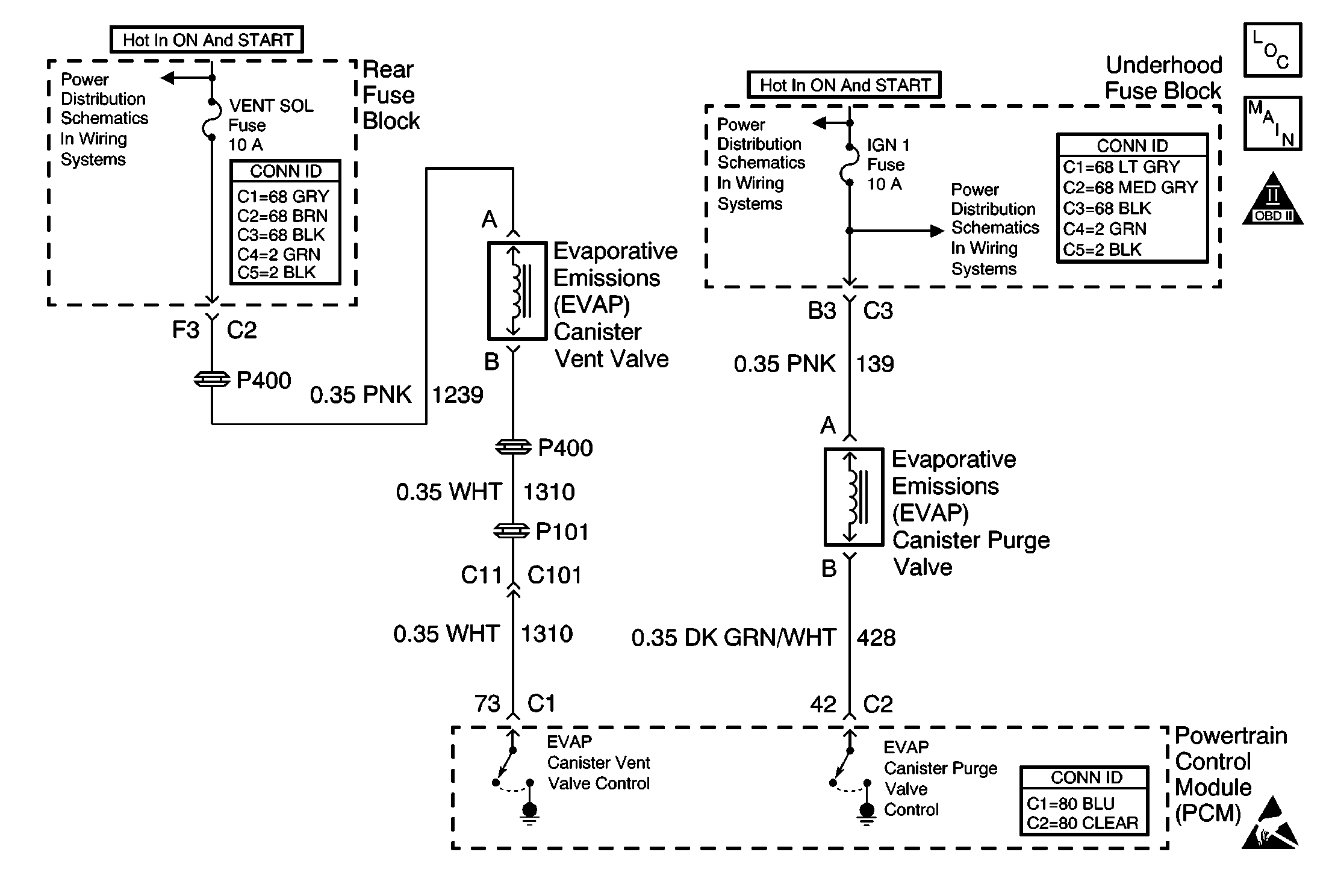
Circuit Description
The PCM uses output driver modules (ODMs) to control many functions of the engine, and the transaxle. The ODMs supply the ground path for the PCM controlled device when the PCM commands the device ON. Each ODM is able to control several outputs. Unlike the quad driver modules (QDMs) used in earlier model years, the ODMs are able to diagnose each output circuit. The PCM monitors the ODMs for circuit conditions that are incorrect for the commanded state of the ODM. If the PCM detects an improper circuit condition in the ODM that controls the EVAP vent solenoid, DTC P0449 will set.
Conditions for Running the DTC
| • | The engine is running. |
| • | System voltage is between 8 and 16 volts. |
Conditions for Setting the DTC
| • | The PCM detects a circuit conditions that is incorrect for the commanded state of the ODM that controls the EVAP vent solenoid. |
| • | The condition is present for at least 10 seconds. |
Action Taken When the DTC Sets
| • | The PCM illuminates the malfunction indicator lamp (MIL) during the second consecutive trip in which the diagnostic test runs and fails. |
| • | The PCM stores the conditions present when the DTC set as Freeze Frame/Failure Records data. |
Conditions for Clearing the MIL/DTC
| • | The PCM will turn the MIL OFF after the third consecutive trip in which the diagnostic runs and passes. |
| • | The history DTC will clear after 40 consecutive warm-up cycles have occurred without a malfunction. |
| • | The DTC can be cleared by using the scan tool Clear DTC Information function. |
Diagnostic Aids
Notice: Use the connector test adapter kit J 35616-A for any test that
requires probing the following items:
• The PCM harness connectors • The electrical center fuse/relay cavities • The component terminals • The component harness connector
If the condition is intermittent, refer to Intermittent Conditions .
Reviewing the Fail Records vehicle mileage since the diagnostic test last failed may assist in diagnosing the condition. The information may help determine how often the condition that set the DTC occurs.
Test Description
The numbers below refer to the step numbers on the diagnostic table.
-
Ignition feed voltage should be present on the control circuit with the PCM disconnected and the ignition turned ON.
-
Checks for a shorted component or a short to B+ on the control circuit.
-
This vehicle is equipped with a PCM which utilizes an electrically erasable programmable read only memory (EEPROM). When the PCM is replaced, the new PCM must be programmed.
Step | Action | Values | Yes | No | ||||||
|---|---|---|---|---|---|---|---|---|---|---|
1 | Was the Powertrain On-Board Diagnostic System Check performed? | -- | ||||||||
Is voltage near the specified value? | B+ | |||||||||
Does the current reading remain between the specified values? | 0.1-0.5 Amps (100-500 mA) | |||||||||
4 |
Was a problem found? | -- | ||||||||
5 | Is the EVAP vent valve fuse open? | -- | ||||||||
6 |
Is action complete? | -- | -- | |||||||
7 |
Was a problem found? | -- | ||||||||
8 |
Was a problem found? | -- | ||||||||
9 |
Does the test lamp flash ON and OFF? | -- | Go to Diagnostic Aids | |||||||
10 |
Was a problem found? | -- | ||||||||
11 | Replace the EVAP canister vent valve. Refer to Evaporative Emission Vent Valve Replacement . Is action complete? | -- | -- | |||||||
|
Important:: Replacement PCM must be programmed. Replace the PCM. Refer to Powertrain Control Module Replacement/Programming Is action complete? | -- | -- | ||||||||
13 |
Does the scan tool indicate that DTC P0449 failed this ignition? | -- | System OK |
